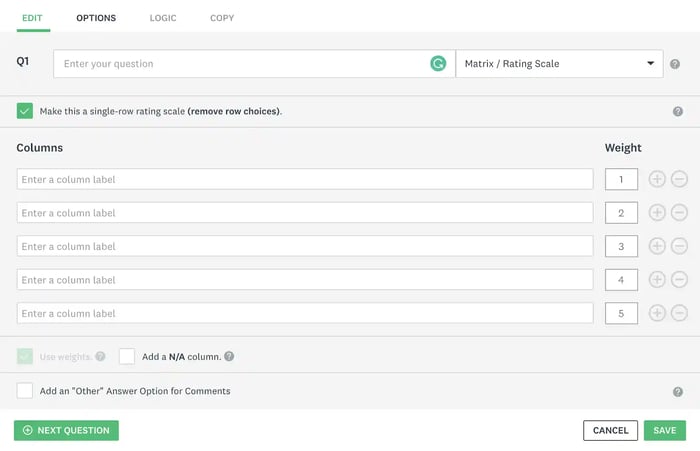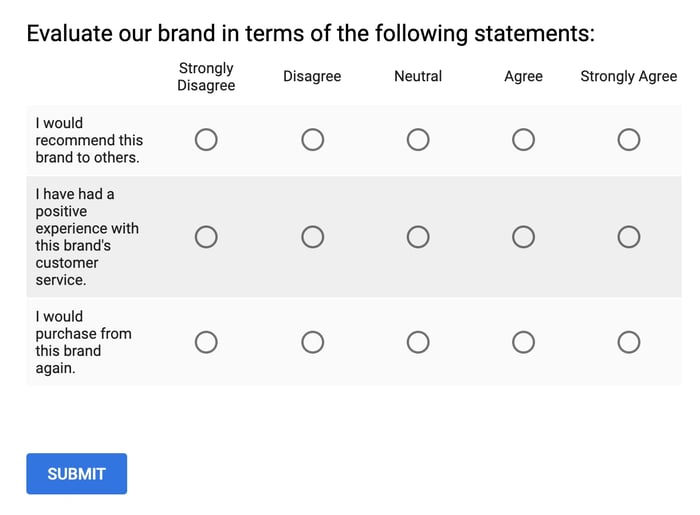No matter how strong your customer retention rate is, you should always want to know how satisfied customers are with your business.

Using surveys to collect customer feedback ensures you’re up to date on the needs of your target audience, and a Likert Scale is an effective type of question scale to use.
In this post, let's discuss what a Likert scale is and how you can use it to optimize your surveys. Then, we'll provide some examples and templates you can use for your feedback collection process.
Table of Contents:
What Is a Likert Scale?
A Likert scale is a closed-ended survey question that measures a participant's opinions on a series of statements. Participants consider the prompt then choose from a selection of answers that range from opposite extremities. Likert scales can have five, seven, or nine points, depending on the level of depth required from participants.
The scale is named after Rensis Likert, who developed the method in 1932 to gauge people’s attitudes toward a topic.
Using a Likert Scale is beneficial because it helps you quantify customer opinions with a five to nine-point scale, helping you easily obtain customer feedback and analyze it for trends and patterns.
These scales are also more focused, which can help you avoid survey fatigue when respondents feel bogged down by the long-windedness of questions and drop off before completing the survey.
In the next section, let's look at how Likert scales can be used in surveys to collect valuable customer information.
Likert Scale Questions
Likert scale questions create consistency when surveying participants on qualitative topics. Rather than letting the participant describe their own experience, they're provided with predefined options to measure it. That way, surveyors can obtain specific feedback using a quantified response.
For example, if you wanted to know how much customers like your logo, you could say, “On a scale of [metric numbers], please rate how much you like your logo.” You could label 1 as “I don’t like it” and 5 as “I love it,” and respondents select their feelings from the scale.
Here are some common examples of Likert scale questions:
1. Product Use Likert Scale Question
If you’re asking customers if they’d be willing to try another one of your products, you could say,
“How likely are you to try our [product name, service name]?” and create a corresponding scale.
2. Repeat Purchase Likert Scale Question
“How likely are you to purchase [product name, service name, etc.] again?” or to make it more general, “How likely are you to make another purchase from [insert business name]?” and create a corresponding scale.
3. Customer Loyalty Likert Scale Question
“How likely are you to enroll in our loyalty program?” with a corresponding scale. Or,
“On a scale of [metric numbers], how loyal do you consider yourself to be to [business name]?”
4. Price Increase Likert Scale Question
“How likely are you to purchase [product or service name] again if the price increases?”
While there are many types of Likert scale questions, the following five are commonly used in surveys.
5 Likert Scale Examples
The following examples are from a survey used to assess how Boston College students felt about the Allbirds footwear brand.
1. Agreement Questions

This is the most common type of Likert scale question as survey creators can list a series of statements about a topic and gauge how much participants agree to them.
2. Frequency Questions

Frequency questions are great for companies who want to judge how often consumers use their products. It can also reveal insights into the everyday routines of each participant.
3. Importance Questions

Importance questions reveal some of the values and beliefs of your customers. They share how important certain aspects of your brand, services, and products are and what areas need to be improved.
4. Likelihood Questions

Likelihood questions determine how true a statement is for a participant. This can also be used to judge the values and beliefs of your audience.
5. Quality Questions

Quality questions test how your products, services, and brand are perceived by customers. This is a good question to use to judge consumer perception after releasing a new product.
3 Likert Scale Templates
1. SurveyMonkey

On SurveyMonkey, you can easily create a Likert scale using the template above. Simply type in your question, select "Matrix / Rating Scale," and check the box next to "Make this a single-row rating scale (remove row choices)."
The template will automatically give you five response options, but you can always add or delete them depending on how many options you'd like to have. Then, fill in a label for each column, such as "never," "rarely," "occasionally," "frequently," and "always." When you hit "Save," it will show you a preview of how the question will look.
2. Google Forms

Google Forms is another simple tool you can use to build questionnaires, including Likert scale questions. First, fill in a question or overarching statement, such as "Evaluate our brand in terms of the following statements." Then, select "Multiple choice grid" as the type of question. Multiple choice grids are perfect if you'd like to ask several questions or list statements that all fall under one type of Likert scale question.
Clicking this will lead you to an option to create "Rows and Columns." Each "Row" should be filled in with a statement or question you'd like to ask participants, such as "I would recommend this brand to others." Each "Column" label should be filled with a point on your scale, like "strongly agree."
Once you've finished, your question will look something like this:

3. Self-Made
You can also create your questionnaire on a document tool, such as Microsoft Word, Pages, or Google Docs. This is a good option when sending out internal questionnaires or if you're printing out and mailing it.
You can type up your questions and have users complete it on the same document, like in the template below.
I am treated fairly by my manager.
___ Strongly Disagree
___ Disagree
___ Neutral
___ Agree
___ Strongly Agree
If receiving the questionnaire digitally, participants can easily place a checkmark or "X" on the option they most agree with. If receiving the questionnaire via hard copy, they can fill it out by hand.
For more ways to gather customer feedback, read about different survey questions.
![→ Download Now: Customer Service Metrics Calculator [Free Tool]](https://no-cache.hubspot.com/cta/default/53/e24dc302-9dc2-466f-a5ca-ab4e08633c0f.png)


-2.png)
![How Automated Phone Surveys Work [+Tips and Examples]](https://blog.hubspot.com/hubfs/phone-survey.webp)
-3.png)


![Leading Questions: What They Are & Why They Matter [+ Examples]](https://blog.hubspot.com/hubfs/leading-questions-hero.webp)
.jpg)
